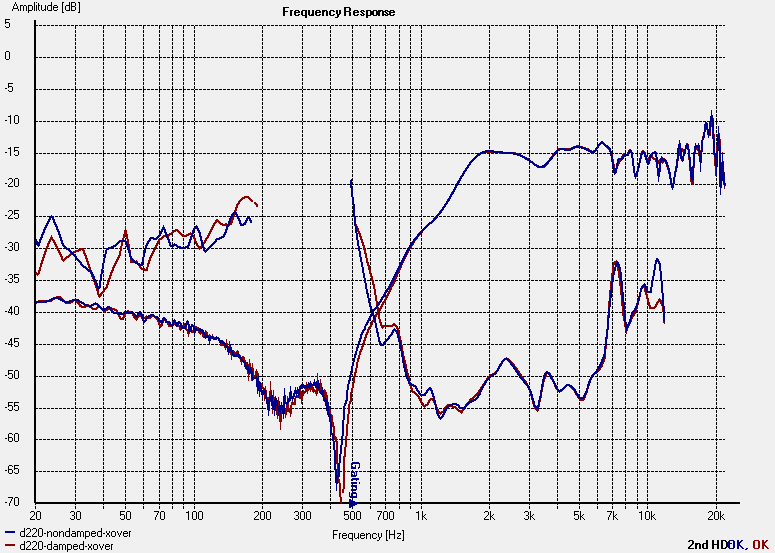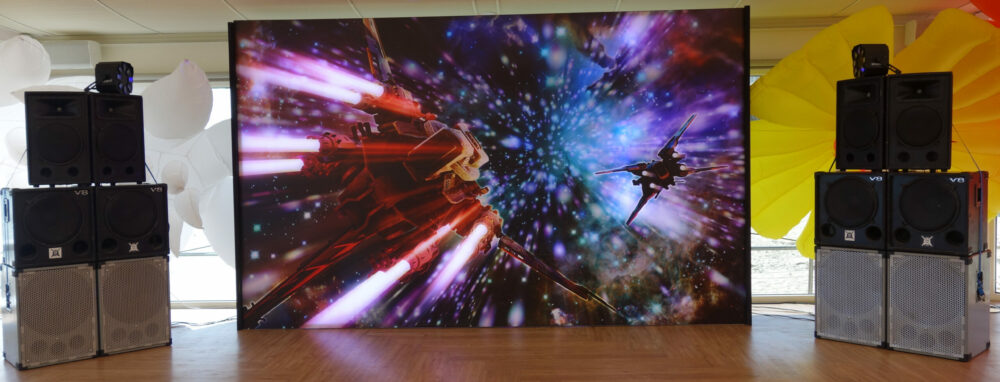This is pretty much a “brain dump” of my Audiokarma posts on phase III of the Econowave project (now more likely to be called the big read speakers then “cheapowaves”)… post will get edited down over time, but if the article is disjointed it’s due to being a bunch of seperate posts appended together.
upgrading woofer in my econowaves : adding the Eminence Delta 12LFA and documenting the resultant crossover redesign.. plus some tweaks
stage 1: prep work before buying the woofer.I’ve been greatly enjoying my econowave speakers this last year, but always thinking I could do better with the woofer, which was an inexpensive Ebay PA driver with very little information available about it. I could never get it to match up with the d220ti cleanly at the crossover point, and ended up using a simple first order LP as the best tradeoff. Without buying the new drivers to measure first hand I’ve been playing around with software tools to using published data and a bit of guestimation. To keep using the existing MDF enclosures (which I quite like) I’m limited to 12″ woofers that play nicely in 120.6L (or less) with 2 (or one if I block a port) 10cm bass reflex ports.
Also theres the actual size of the woofer rebate and hole fitting to take into account, some of the drivers which look really good would mean extensively reworking the rebate and repainting (the Beyma 12BR70 for example, which otherwise looks like it would be great).The Delta 12LFA looks like it matches very well, and will drop in the existing cabinet with minimal modification. The T/S parameters indicate it will play very well with the 120L box I have with the existing ports.I dont have a 12LFA to measure, so I used SPLtrace to make a .FRD file from the PDF specs, and used that with speaker workshop and the d220ti+PH612 measurements I already have. This is where the fiddle factor comes in, I didnt calibrate my measurements(they were relative to the woofer response done in the same session), so I’ve just scaled up my FRD response to look similar in magnitude to Seleniums published one… I’m also hoping the L-PAD adjustment makes this point largely moot anyway as it can be “dialled in”.With Speaker Workshop, bouncing around variations on the Ewave high efficiency crossover, etc, I’ve settled on a using a 3rd order LP so as to get a fairly steep cuttoff to tame the huge bump at 2K while stil keeping the rest of the response fairly flat.
I’ve also lowered the cuttof point on the HP so to suit.. (with a bit of smoothing), gives what looks like an OK result.
If I do get the driver I’ll measure everything and may have to adjust values to suit reality, but I’m hoping it won’t be too different and I can get results in the same area as these estimates with some component value tweaking: LP : 1500Hz (3rd order) HP : 2500Hz (I think)
info from Eminence: http://eminence.com/pdf/delta-12lfa.pdf Quote:
Originally Posted by Zilch  Looks like that’s going to work.I’ve had very good results simming in PCD this year, so I’m a believer…. Looks like that’s going to work.I’ve had very good results simming in PCD this year, so I’m a believer….  |
stage II: getting the speakers and using real measurements in situ in the cabinets OK, once I got past the fixed circuit layout restriction – which isn’t that restrictive as most passive crossovers do follow the same layouts, now I’m impressed…so following on from my previous post where I had a prototypical crossover worked from the manufacturers response curve.. of course once I got the eminence Delta 12LFAs and measured them in the real world, the shiny smooth factory curve that was so easy to shoehorn into a flat line turned out to be a lot more challenging, so I had to revisit the crossover, and I was quite stuck for a while using Speaker Workshop to slowly work through different layouts. SPLtrace data against my measured with cabinet data for Delta 12LFA, scaled so they overlay:
Part of this was the time and mouseclicks taken to change a component value, recalculate, view response graph on SW, while the same operation in PCW is instantaneous.new Delta 12LFA and the current Pioneer woofer:
I also read through some of the existing Econowave designs, loaded in the FRD and ZMA files for the Econowave SR Compact (as my current proposed crossover shows!), this was very informative checking out against another dataset, for instance my measured d220ti + Pyle WG curve pretty much exactly overlays the Econowave SR Compact curve, which is encouraging that my measurements are OK.I also switched to Holmimpulse for measurements, to use its gating function, and made a set of measurements outside. My back yard is not huge, but with the speaker on its back there is no “back wall”, and hopfully the irregular shape of the vegetation diffused some of the reflections.
After trying all sorts of layouts with the resultant data in both Speaker Workshop and PCW I’m currently tending towards a variation of the Ewave SR compact crossover but using a Zobel impedance correction on the woofer.response in PCW:
response in SW (some smoothing applied):
I got the Eminence Delta 12LFA from local (Melbourne) dealer Essential Audio. The hard bit was having to enlarge the hole by 2mm around to fit, which was done by running around the inside of the hole with a jigsaw twice:
..luckily the screw holes lined up from the previous driver exactly.
.. now the next step is to adjust the above circuit to use values available from combinations of Jantzen components or similar, and price up a list.
Quote:
Thanks.. and I have yet to get more advanced as I’m working mainly with basic frequency data here taken from one point.
I already noticed one minor error in the speaker workshop circuit.. I’d swapped the values for the Zobel..
now looking a bit flatter with:
Rz1 as 7.6 ohms and Cz1 as 13uF.. thinking of running with 8.2 ohms and 15uF as they are available stock values that also graph out ok. followup: tidied it up a bit
corrected and cleaned up crossover using component values I can buy (using Jantzen components for pricing it up):
The difference in evenness and depth of the bass from the Eminence Delta 12LFA is quite impressive, and the level of clarity from having a more even response across the board is amazing. They look nearly the same but it’s a whole different speaker.
It’s still maybe a bit bright sounding on some music, so yes having the LPAD done properly so I can tune the HF will be handy.I took some quick indoor measurements @ 1M but havent hauled them outside to do better measurements. I note that my simulation doesn’t completely match the calculated response.. though the notch filter might be quite sensitive to component tolerance.. and doesnt include the inductor resistance.
grey – measured response
black – modelled response (using driver response taken in the same session) Quote:
One of my starting points was the zobel/1mH/10uF crossover for the Delta 12LF described in Wayne Parhams document, but that didnt work to well with the d220ti in PCW or SpeakerWorkshop. I basicly ended up with the LP values advised by PCW, slightly adjusted, and the recomended Zobel values as well, after working through the Econowave SR Compact HF crossover but nudging the numbers around until the graph looked flatter. part III: sidetracked by some tweaks to the compression driver housing and waveguide.
|
HOLMIMPULSE has a graph of THD it produces from it’s sweep, it would be interesting to see if that changes much with the damped plastic casing.
|

But the last few months I’ve had the remodelled crossovers laid out on cardboard while I’ve been tuning them. What a mess!
The original crossover I specced out in the above circuit sounded just a bit too bright too me, and trying different with attenuation via various resistor LPAD combos it didn’t quite sound right. What sounded OK on one style of music sounded terrible with another.I ended up trying various values out of curiosity, simming them up in speaker workshop for a sanity check, then adding them to the crossover and having a listen.Adjusting the values of the RC high frequency compensation network yielded much better results, even though “on paper” it has more of a slight tail off in the high end than the “flat” values I started with.I ended up trying a bunch of assorted capacitor/resistor values over a few weeks:
..
also tweaking the values in the notch filter (taken from the Econowave SR crossover) to make it bit flatter around the crossover point.
I ended up adding a 1uF cap in parallell to the 8.2uF cap for a total of 9.2uF.The RC network I settled on was 14ohm/1.77 uF, made from 4 x 56 ohm 3watt resistors in parallel, and a 1uF cap with a 0.68uF cap.final crossover – it’s interesting these are closer to the original values I chose in the first iteration of this crossover before adapting to the closest standard values:
Now to clean up the messy crossovers and put them properly on the circuitboards:
I had to mount the high pass inductor upright as I had gotten a larger size than would sit down snug, also the notch filter inductor I bolted to the side of the enclosure using a bracket I fashioned from polymorph plastic.
Also the Jantzen inductors I used didnt have screw holes, so they are cable tied down I’ve damped them from rattling about with some ugly, but functional blobs of hot glue:

Pingback: beyond econowave : Faital Pro HF144 compression driver with LTH142 Tractrix horn | MiniRIG